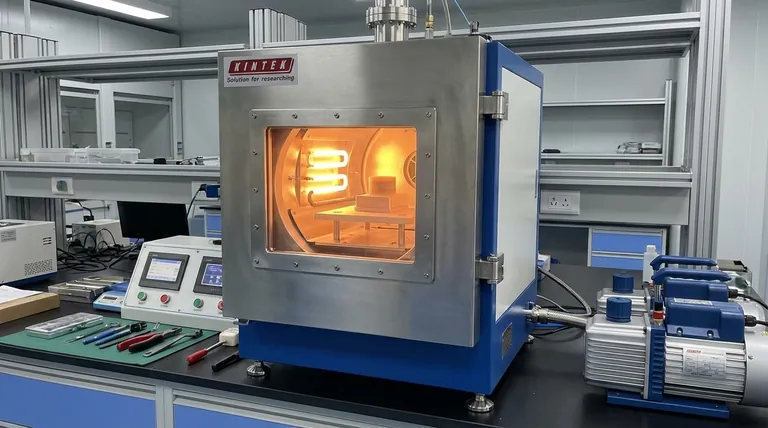Yes, heat absolutely transfers through a vacuum. While the familiar methods of heat transfer—conduction and convection—require a medium to move energy, a vacuum stops them cold. Instead, heat travels through the emptiness of a vacuum via thermal radiation, a process that transfers energy in the form of electromagnetic waves.
The crucial distinction is that heat transfer by conduction and convection relies on the movement of molecules, which are absent in a vacuum. Thermal radiation, however, does not require a medium, making it the sole method of heat transfer across empty space.

The Three Modes of Heat Transfer
To understand why a vacuum is so effective at insulation, we must first distinguish between the three ways heat can move.
Conduction (The Molecular Touch)
Conduction is heat transfer through direct contact. When you touch a hot stove, energy moves directly from the stove's vibrating molecules to yours.
Without molecules to touch each other, conduction cannot occur across a perfect vacuum.
Convection (The Moving Fluid)
Convection is heat transfer through the movement of a fluid (a liquid or gas). A convection oven works by circulating hot air, which carries thermal energy to the food.
Since a vacuum has no air or fluid to circulate, convection is also impossible.
Radiation (The Electromagnetic Wave)
Radiation is the transfer of heat via electromagnetic waves, such as infrared radiation. This process does not require any matter to be present.
Every object with a temperature above absolute zero emits thermal radiation. This is how the Sun's heat travels 93 million miles through the vacuum of space to warm the Earth.
How Radiative Heat Transfer Works
Understanding the mechanism of radiation is key to seeing how it dominates in a vacuum.
Emission of Energy
An object, like a heating element in a vacuum furnace, emits its thermal energy as electromagnetic waves. The hotter the object, the more energy it radiates.
Traveling Through Emptiness
These waves travel outwards from their source at the speed of light, passing unimpeded through the vacuum.
Absorption and Temperature Increase
When these waves strike another object, such as a material being treated in the furnace, the energy is absorbed. This absorption causes the molecules in the target material to vibrate more rapidly, which we measure as an increase in its temperature.
Understanding the Practical Implications
The unique nature of heat transfer in a vacuum has significant real-world consequences and applications.
The Vacuum Flask (Thermos)
A vacuum flask is designed with an inner and outer wall separated by a vacuum. This gap effectively stops heat transfer by conduction and convection. The walls are often silvered to reflect thermal radiation, further minimizing heat loss or gain.
Spacecraft Thermal Management
A satellite in the vacuum of space has a serious engineering problem: it can only cool itself by radiating heat away. This is why satellites use specialized radiators and surface coatings to manage their temperature.
Controlled Industrial Processes
In processes like vacuum induction sintering, a vacuum is used to heat materials. This prevents contamination from air molecules and ensures that heat is transferred purely by radiation, which can be precisely controlled for high-quality manufacturing.
Making the Right Choice for Your Goal
Understanding this principle allows you to leverage it for specific engineering or design goals.
- If your primary focus is thermal insulation: The goal is to stop all three forms of heat transfer. Create a vacuum gap to eliminate conduction and convection, and use highly reflective surfaces to minimize radiation.
- If your primary focus is heating a material cleanly: Using a vacuum ensures heat is delivered purely by radiation, preventing unwanted chemical reactions (like oxidation) that would occur in the presence of air.
- If your primary focus is cooling an object in a vacuum: Your only option is to maximize radiative heat loss. This requires designing surfaces with high emissivity that can efficiently radiate thermal energy away.
Mastering how heat behaves in a vacuum is fundamental to engineering everything from a simple coffee thermos to a complex interplanetary satellite.
Summary Table:
| Heat Transfer Method | Mechanism | Possible in a Vacuum? |
|---|---|---|
| Conduction | Direct molecular contact | No |
| Convection | Movement of fluid (liquid/gas) | No |
| Radiation | Electromagnetic waves (e.g., infrared) | Yes |
Ready to leverage the principles of vacuum heat transfer in your lab?
KINTEK specializes in high-performance lab equipment, including vacuum furnaces and thermal management systems that utilize controlled radiative heating for clean, precise, and contamination-free processes. Whether you're involved in materials research, sintering, or need reliable thermal insulation solutions, our expertise ensures optimal performance and results.
Contact us today to discuss how our solutions can enhance your laboratory's efficiency and accuracy!
Visual Guide

Related Products
- Vacuum Heat Treat Furnace with Ceramic Fiber Liner
- Vacuum Heat Treat Furnace and Levitation Induction Melting Furnace
- Molybdenum Vacuum Heat Treat Furnace
- Vacuum Heat Treat and Molybdenum Wire Sintering Furnace for Vacuum Sintering
- Vertical Laboratory Quartz Tube Furnace Tubular Furnace
People Also Ask
- What materials are used in a vacuum furnace? A Guide to Hot Zone Materials and Processed Metals
- Can I vacuum the inside of my furnace? A Guide to Safe DIY Cleaning vs. Professional Service
- What is the standard thickness of plating? Optimize Durability, Corrosion & Cost
- What are the advantages of a vacuum furnace? Achieve Superior Purity and Control in Heat Treatment
- What is the maximum temperature in a vacuum furnace? It Depends on Your Materials and Process Needs



















